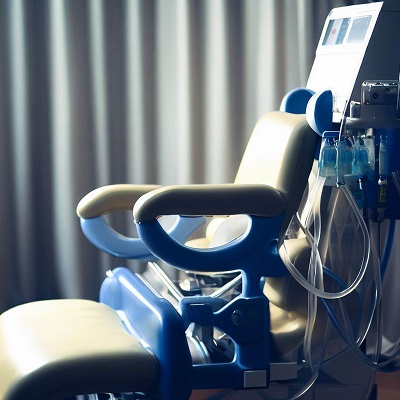Dialysis serves as a life-preserving beacon for individuals battling kidney failure. By emulating the kidney's role of cleansing the blood, it provides patients with an extended lease on life. However, with dialysis sessions often extending to several hours, the significance of the patient's seating—a dialysis chair—becomes profoundly evident. In this comprehensive guide, we'll explore the intricate role a dialysis chair plays in ensuring not only comfort but paramount safety during treatments.
“As someone who has been on dialysis for over five years, I can't stress enough the importance of a good chair. It's where I spend hours every week.” - Patient Testimonial by Maria T.
A life-saver for those with compromised kidney function, dialysis is the process of artificially removing excess water, solutes, and toxins from the blood. Primarily, there are two types:
Hemodialysis: Conducted externally, this method circulates the patient's blood through a machine that filters out impurities before returning it to the body.
Peritoneal Dialysis: Using the patient's peritoneal membrane in the abdomen, this method filters blood internally by filling the abdomen with a dialysate solution which draws out impurities.
Given the severity of kidney ailments, most hemodialysis patients attend sessions three times weekly. Each session can last anywhere between 3-5 hours. This extended duration underscores the critical importance of the patient's seating arrangement, leading us to the dialysis chair's significance.

Beyond a mere seat, the dialysis chair is a pivotal component of the treatment:
Stability: A chair ensures patients remain securely positioned, preventing potential complications during treatment.
Accessibility: It offers medical staff unfettered access to vital areas, particularly where the dialysis machine connects to the patient.
Comfort: Given the session's longevity, the chair becomes an oasis of comfort, reducing physical strain.

Expert Insight: “The perfect blend of design and functionality is vital in a dialysis chair. The risk of infections or other complications can be significantly minimized with the right choice.” - Dr. Alan Reynolds.
Safety first! A dialysis chair's design prioritizes patient security. Here's how:
Anti-tip Mechanism: The chair is crafted to resist tipping over, ensuring patient safety even during movements or adjustments.
Weight Considerations: Strategic weight distribution in the design ensures stability, catering to diverse patient sizes and postures.
In a setting as sterile as dialysis, the chair's cleanliness is paramount:
Non-porous Materials: Essential to avoid absorbing spilled fluids and ensure ease of disinfection.
Bacterial Resistance: Cutting-edge materials are used that naturally repel bacterial growth, ensuring a sanitized environment.
Tailoring to individuality, modern chairs come equipped with:
Height Adjustability: This facilitates safe patient transfers, reducing potential physical strain.
Customizable Rests: Adjustable arm and footrests cater to individual needs, further enhancing safety and comfort.
Embracing technology, modern chairs come embedded with:
Alert Systems: These sound alarms during anomalies, such as a patient slipping.
Integrated Adjustments: Some chairs are interconnected with the dialysis machine, automatically adjusting settings in real-time for optimal safety and efficiency.

“My previous dialysis center had rather basic chairs and I often left with a sore back. Since moving to a center with ergonomic dialysis chairs, my overall experience has vastly improved.” - Patient Testimonial by David L.
Crafted for comfort, dialysis chairs prioritize ergonomics:
Lumbar Support: This essential feature prevents potential backaches, ensuring patients remain comfortable throughout their session.
Pressure Distribution: Adequate cushioning ensures even distribution of pressure, mitigating the risk of sores.
Personalized for patients, many chairs offer:
Memory Functions: These store individual settings, streamlining setup for recurring sessions and guaranteeing consistent comfort.
Adding a touch of luxury, some chairs are equipped with:
Massagers: These soothe muscles during prolonged treatments.
Heating Elements: These provide a gentle warmth, boosting circulation and overall comfort.
Personal Device Ports: Allowing for entertainment, these ports enable patients to immerse in activities, making lengthy sessions more bearable.

Statistical Insight: A recent study showed that patient satisfaction in dialysis centers with technologically advanced and ergonomically designed chairs was 80% higher than in those without.
Expert Insight: “With the rapid advancements in AI, we're approaching a future where dialysis chairs will automatically adapt to patient needs, offering unparalleled safety and comfort.” - Prof. Helena Gomez.
As we stand on the cusp of a technological revolution, we can anticipate chairs that:
Smart Adjustments: Leveraging AI and IoT, future chairs might tweak settings in real-time based on a patient's vitals, further enhancing their safety and comfort.
Progress in materials science hints at:
Next-gen Comfort: Chairs that maximize patient comfort while being effortless to sanitize.
Sustainability: With global sustainability drives, eco-friendly materials will become the norm in healthcare furnishings.
In the realm of dialysis, a chair is not just an object—it’s a vessel of patient care, safety, and comfort. As we move forward, technology and design evolution will further enhance this essential piece of medical equipment. By understanding its vital role, we can optimize patient care today and innovate for an even better tomorrow.
“Having visited several dialysis centers globally for conferences and evaluations, I can attest to the rising emphasis on chair design and technology. The patient's experience is central to care, and the dialysis chair is pivotal in this equation.” - Expert Insight by Dr. Satish Kumar.
By understanding its vital role, we can optimize patient care today and innovate for an even better tomorrow.